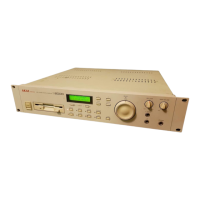SINGLE MODE
Page 52 S2000 Operator’s Manual - Version 1.30
SINGLE VS MULTI
As mentioned, you may achieve similar results in the MULTI mode where you can create multi-
timbral setups, key splits, layered programs (and combinations of these) very quickly and
easily. The advantages MULTI has over the ‘old Akai’ methods are
• Selection of programs for a part is quick and easy.
• You can try out different sounds very easily and is therefore ideal for loading in, say, a few
pianos, a few basses, a few drum kits, etc., and experimenting with different combinations
of sounds. Equally, when layering, choosing and experimenting with combinations is
extremely quick.
• When changing sounds, any mixer parameters, effects assignments, etc., you may have
set in the MULTI remain constant so you do not have to reset everything every time you
change a sound.
• You can use the same program several times in a MULTI. For example, you may layer a
strings program (or whatever) on top of itself with some detune for a richer sound simply by
applying the same program to two (or more) parts, giving those parts the same MIDI
channel and setting a FINE TUNE value for each as appropriate (to achieve the same result
in SINGLE requires that you make a copy of the program).
• In the case where a program is layered on top of itself for detuning, editing one of them will
affect both so that you can make changes to the whole sound with one sionple action (for
example, layering a string pad on top of itself with some detune and editing the attack of
one of the parts will cause both parts to be affected).
• You may select different programs independently on different MIDI channels (i.e. send a
program change on channel 5 to select a new string sound in part 5).
• You can save the multi file with a meaningful name (i.e. BACK TRACK 3 or the name of the
song, whatever).
• If you are new to samplers, the MULTI mode corresponds more with most other sound
module’s implementation that you may be more familiar with.
The disadvantages of MULTI are:
• Only one multi file may reside in memory at once (although any number may be saved to
disk and subsequently re-loaded).
• You can’t have more than sixteen programs active at any one time.
The advantages of using the ‘old Akai’ method are:
• You can have several multi-timbral setups or layers in memory at any one time and recall
them with a single MIDI program change (ideal for live work where you may have the
backing tracks for all your songs in memory).
• You can have more than sixteen programs active at once (although there are not more than
sixteen MIDI channels, you may have layered programs in a multi-timbral setup).
The disadvantages, however, are:
• Changing sounds in a multi-timbral setup and experimenting with different combinations of
sounds in the SINGLE mode can be awkward (for example, you must flick between
SINGLE and EDIT to set the program number and MIDI channel every time you wish to
change sounds).

